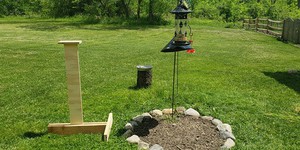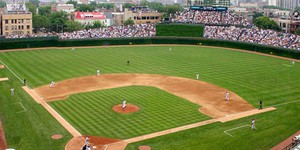Others Like “Practice” (top 20 results)
|
Block off one-third of a soccer net with a cone, 5-gallon bucket or some other suitable object. Shoot into the smaller side from a set distance, but systematically varying the angle to the goal line. Take enough shots at each angle to get a reliable sample. How does success vary with angle? For a basic project: How do you think your success rate will vary with angle? Draw a conclusion from your experimental results. A bar graph showing success rate at different angles can help to…
Read more
When the punter is trying to hit the "coffin corner" (within the opposing team's 10-yard line), out of bounds, what is the best angle to kick the ball for correct distance and maximum "hang time?" (For more information on the physics involved, see: Gay, 2004, Chapters 4 and 5.)
Read more
You can model this with an ice cube sliding down a plank: how high do you need to lift the end of the plank before the ice cube starts to slide? Try this with one side plain wood and the flip side waxed wood (use paraffin wax, candle wax or ski wax). Make sure both sides are equally smooth to start with. Do at least three trials. More advanced: using what you know about the forces acting on the ice cube, derive equations to calculate the coefficient of friction for each case. Variation:…
Read more
You'll need: a puck, a hockey stick, a tape measure, at least one helper with a stopwatch and an empty rink. Have your friend start the watch just as you make contact with the puck, and stop it when the puck hits the boards. Measure the distance and divide by the time to get the speed of the puck. With two helpers and two stop watches, you can time the puck at center ice and at the far end. Are the speeds the same? How about if you don't follow through, but stop your stick as soon as it…
Read more
Many sports skills require quick reaction times: think of hitting a 95-mph fastball, returning a 100-mph tennis serve, or blocking a slapshot at the net in hockey. (The Experimental Procedure section below has one way to measure reaction time.) Is your right hand faster than your left? Can you improve your reaction time with practice? Do both hands improve if you only practice with one hand? Try relating your reaction time to real situations in your favorite sport. For example, calculate…
Read more
Swish! What a great sound when you hit the perfect shot and get nothing but net. Here's a project to get you thinking about how you can make that perfect shot more often.
Read more
The goal of every golfer is to hit the golf ball as far as possible down the fairway. A key factor in determining the distance that the ball will travel is the velocity of the club when it strikes the ball. In this sports science fair project, you will determine exactly how distance is related to club velocity. Time to tee off!
Read more
Mike Powell of the United States currently holds the world record for the long jump at 8.95 meters, which is almost 30 feet! How did he jump so far? In this experiment, learn how a long jumper uses momentum from running to jump farther than the competition.
Read more
This project idea is inspired by former NASA engineer Mark Rober's "Squirrel Ninja Obstacle Course":
You do not need to build a full obstacle course as intricate as Mark's (although you certainly can if you want to!) to make this into a fun science project. For example, how far can squirrels jump? You could test this question by building a mobile post and placing it next to a bird feeder. The bird feeder in Figure 1 is mounted on a metal pole. The pole is protected by a squirrel baffle, a…
Read more
What do Nolan Ryan, Mark Wohlers, Armando Benitez, and Roger Clemens have in common? These men are all major league baseball pitchers who have pitched baseballs at 100 miles per hour or greater! What does it take to throw a baseball this fast? Does it come down to having the biggest muscles? Can a ball thrown this fast also be accurate? In this sports science fair project, you will learn about the biomechanics of pitching. Investigate how body position and physics interact to produce fast…
Read more
|
Explore Our Science Videos
Racing Drones: Does Practice Make you Faster?
Squishy Circuits Introduction
Flower Dissection – STEM Activity








